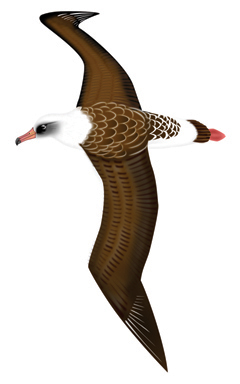Laysan Albatross

Common Name: Laysan Albatross
Scientific Name: Phoebastria immutabilis
Description
Laysan, Black-footed, and Short-tailed Albatross have a wingspan of almost two meters, which is half that of the largest albatrosses. Albatrosses do not nest in Alaska but they migrate here each year after having bred in such far away places as the Northwestern Hawaiian Islands and Torishima Island in Japan. On these remote uninhabited islands, albatrosses nest in huge, dense colonies. Nearly all of the 400,000 breeding pairs of Laysan Albatross and 50,000 pairs of Black-footed Albatross nest in the Northwestern Hawaiian Islands.
White head, neck, and underbody. Black mantle and upperwings. Underwings have black margins and irregular streaks on converts. Dark eye patch.
Bill varies from gray to yellow with darker tip; pink legs/feet.
Length: 79-81cm (31.6-32.4 in);
Wingspan: 195-203 cm (6.4-6.7 ft);
Average Life Span: 12-40 yrs.
Life History
Reproduction Comments: Egg are laid November-December. Clutch size is 1. Incubation lasts 62-68 days, by both sexes in turn (turn may last weeks). Nestling stage lasts about 165 days. Young are tended by both sexes, may be left alone for 1-4 days after 6 weeks. First breeds at 5-9 years.
Habitat
Marine Habitat(s): Pelagic
Terrestrial Habitat(s): Grassland/herbaceous
Feeding Habits
Primarily nocturnal feeders. Laysans are surface feeders. Therefore feed on anything that floats on the surface of the water; squid, fish, crustaceans and flying fish eggs.
Laysans usually stay at least 20 to 30 kilometers offshore during the non-breeding months (July - October). During these months Laysans are distributed throughout the northwestern and northeastern range of the Pacific.
Breeding
Monogamous. If one of the mates should die, they will most likely create a new pair bond. Nests are made up of surrounding grasses, dirt or shrubbery and are piled into large mounds that form a nest cup. Laying begins in mid-November. One egg is laid and incubation lasts about 65 days. Incubation starts with the female who usually stays for a short two day span. The male then takes over for as long as three weeks. During the month of December the number of incubating males outnumber that of incubating females 15:1. If the egg is infertile or breaks during incubation, re-laying will not occur that year.
Chicks hatch during late January to mid-February. Chicks live off a diet of flying fish eggs and squid oil, a product that is rich in fat. Both parents will feed the chick by regurgitation and will often leave them for several days while they obtain food out at sea. The rich squid and stomach oil is filled with fatty acids and nutrients that can sustain a chick for the number of days between feedings. Fledging occurs 5-6 months after hatching (mid-June through late July). Parents will often leave before the chicks have reached their full juvenile plumage.
Sub-adults return to their natal nesting colony after spending 3 - 5 years at sea. Elaborate courtship dances take place throughout the colony while these young birds search for a mate. Mating and first nesting usually occurs by age 6-8.
Identification Tips
- Length: 28 inches Wingspan: 85 inches
- Sexes similar
- Large seafaring bird with extremely long wings
- White head, body, undertail coverts, and rump
- Upperwings and back dark
- Black and white patterning on underwings
- Bill and feet pinkish
- Similar Species
Similarly pelagic shearwaters and petrels are smaller with shorter wings. Black-footed Albatross has a dark body and head. Other albatross species are rarer and have different patterning on the underwings.
 Deep Sea Crabs
Deep Sea Crabs